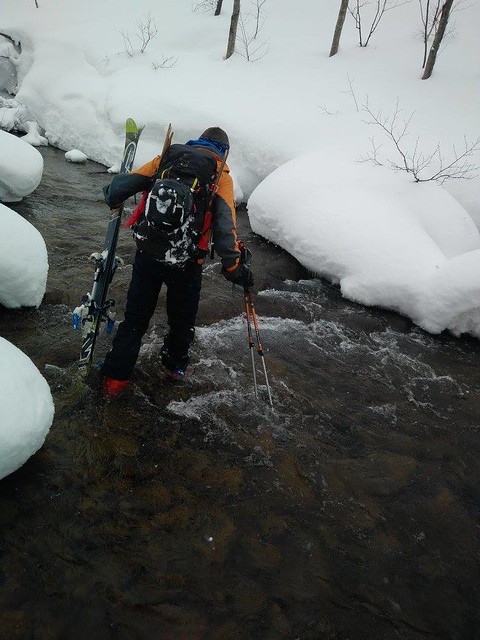Drawn by its relative close proximity to Sapporo City, and the promise of some great skiing on the southwestern ridge, three of us made the trek to Mt. Kimobetsu early on a Saturday morning. I had rented a car the evening before from my favorite budget rental place – Nikoniko Rentals – and was in central Sapporo by 5:45am to pick the lads up.
From central Sapporo, it is just under 1.5 hours by car up and over Nakayama Pass, to the cleared car park area 400m south of the official starting point of the winter trail up Mt. Kimobetsu. By the time we arrived at around 7:30am, we were still the first car there – indeed, we would end up breaking trail the whole way up to the summit.
From the carpark, we followed the Yuki-yama Guide recommendation to walk up the road for 400m or so, to start after the second bridge. It would be just as feasible to head straight up from the carpark, however, and skirt around the hill to a forestry road above the carpark (as indicated by my tracklog above – the route we took when descending off the mountain). This would avoid the inglorious scramble up to the unmarked trailhead from the road…As well as the lengthy search for a suitable snowbridge over the creek, about 1km from the trailhead.
After crossing the creek, the route meanders up and over (and along, at times) a forestry road to a set of powerlines. The route doesn’t hang around near the lines for long before connecting with the southwestern ridge proper. This broad ridge, around 30 degrees in places, and dotted with large well spaced out trees, is a prime location to practice multiple long zigzags up the slope.
Once at the top of the ridge, most of the upward slog is done. The wind was howling when we were up there, so Rick left course flags in our wake as we headed on, as an extra precaution should the weather turn really foul. Even though I was using a GPS route map app on my smartphone (I like the Japanese Chizu-roid (地図ロイド) app for displaying official Japanese topographical maps), these flags were super handy to keep us from dropping down too far west off the summit on the way down in near-whiteout conditions.
The further we got up on the summit ridge, the windier it got. By the time we had arrived at the summit, it was nearly a white-out. The howling, frigid wind soon laid to rest any ideas of sitting down for a leisurely lunch before descending.
As per the guidebook, it was indeed a very temptatious descent, with the western drop off the summit beckoning us down the wrong side of the southwest ridge. The need to retrieve Rick’s course flags as we descended forced us to check our location and direction regularly, which also kept us on course. The GPS track on my smartphone would have done the same thing, but even 30 meters down the wrong way is not fun in those conditions.
Once reunited with our zigzags tracks on the southwest ridge, however, we could let loose a little. Nate, a native to skiing, was in his element. “I never really imagined that I’d be here in the Hokkaido backcountry, skiing the sort of snow I’d only seen in Warren Miller films,” he said – big grins all around.

At the end of the steeper part of the downhill, we stopped for a late lunch. Nate summed up the trip well, saying “the downhill was great, but we sure did have to work for it!”
We made up for the exertion on the way home with a long soak in the Matsu-no-yu onsen (here) and ramen at the best ramen place on this side of Sapporo (according to Rick) – The Shirakaba Sanso ramen shop in Makomanai (here).
A short note on the very end of the descent
We decided to take a more direct route to the car, skirting around the 570m-ish peak above the carpark, rather than follow our tracks to the road above the second bridge up the road from carpark. This is a double-edged sword in that it gets you right above the carpark (and avoids needing to walk along the road), but it does involve some ever-so-slight uphill tramping, and then lengthy traversing.
If you’d rather avoid walking on the narrow road-edge, take the route we took. Otherwise, stick to your uphill track and walk down the road. Do make sure to resist the urge to drop down too soon. Keep traversing until you are well and truly above the carpark. Otherwise, you may end up like two of our party – who shall remain nameless – who had to pay dearly for not resisting the sweet siren calls from the bottom of the gully. At least we now know for sure that Dynafit ski boots are not 100% waterproof

















2 thoughts on “Kimobetsu-dake Southern Ridge Ski Touring”
*A further note on the end of the descent*: Somewhere between the two routes you can also drop in for about 4 really nice, steep turns and then land in the river. This is not exactly recommended, although those were some of the best four turns of my day.
You just need to keep the momentum up, right? More speed = less likelihood you’ll break the surface of the water.